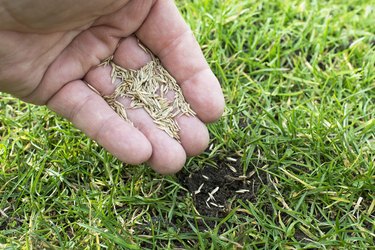
Getting rid of weeds before seeding a new lawn is an important first step to ensure you get lush green grass. Roundup is a non-selective weed and grass killer which makes it a great option when preparing to seed your lawn. Seeding after Roundup can be done safely after a short wait time.
Seeding After Roundup
Video of the Day
After you apply Roundup to kill the weeds, you will need to wait for a period of time before seeding after Roundup. The amount of time varies depending on the Roundup product you select. If you are using products such as Ready-to-Use Weed & Grass Killer III, Weed & Grass Killer Concentrate Plus, or Weed & Grass Killer Super Concentrate, you can begin planting grass seed after just three days, advises Roundup.
Video of the Day
Other products require a longer wait time. You will need to wait 30 days before planting after using Roundup Poison Ivy Plus Tough Brush Killer Products and four months after applying Roundup Extended Control Weed & Grass Killer Plus Weed Preventer Products. Check the product label to determine the amount of time you need to wait before seeding.
Prepare the Soil
Killing weeds is just one of the necessary steps when planting grass seed. Contact your local extension office to get a soil test done to check the nutrient and pH levels of your soil. The results will tell you about any deficiencies and recommendations. After the weeds have been killed, rake up and remove the dead plants and other rocks and debris.
Add soil amendments such as compost and lime as recommended by the soil test. Incorporate the soil amendments by tilling them into the top 4 to 6 inches of soil. Make sure the soil is moist but not wet when tilling. If you till wet soil, it is more likely to become compacted when it dries. Rake the prepared soil to smooth it out and remove any rocks or debris that may have come up while working the soil.
Planting Grass After Roundup
Plant grass seed by spreading it evenly across the soil. You can do this by hand but you can get more even coverage using a lawn spreader. Apply half of the grass seed moving back and forth across the lawn. Then, to ensure even coverage, apply the other half in lines perpendicular to the first application. If you applied the seed moving north and south in the first pass, move east and west for the second pass.
Use a water roller to gently press the grass seed into the soil. Experts recommend applying a starter fertilizer, such as one with an NPK value of 12-25-10, to help the grass seedlings get established. Water the seeds gently. Avoid a heavy stream of water that may wash away the seeds. Continue to gently water the seeds several times a day to keep them moist. Once the seeds germinate and seedlings are at least 1/2 inch tall, you can water less often.
Avoid any traffic on the newly seeded lawn until it has been mowed a couple of times. You can mow when it grows tall enough. The height for mowing varies depending on the type of grass and your preferences.